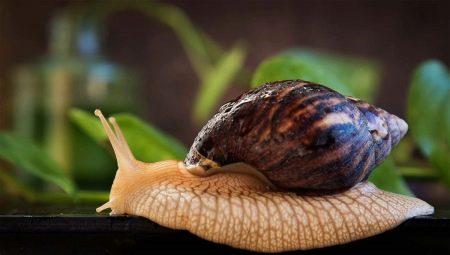Exotic guests for Russia - Achatina snails - do not occur in the wild in the climate of Northern Europe, but they become wonderful pets. They do not make noise, are hypoallergenic, spend most of the time in the container allocated for them. Giant African domestic snails are fairly cheap to maintain and easy to breed. Spectacular appearance, leisurelyness, the ability to recognize the owner - these are just a small part of the reasons why Achatina become real pets.
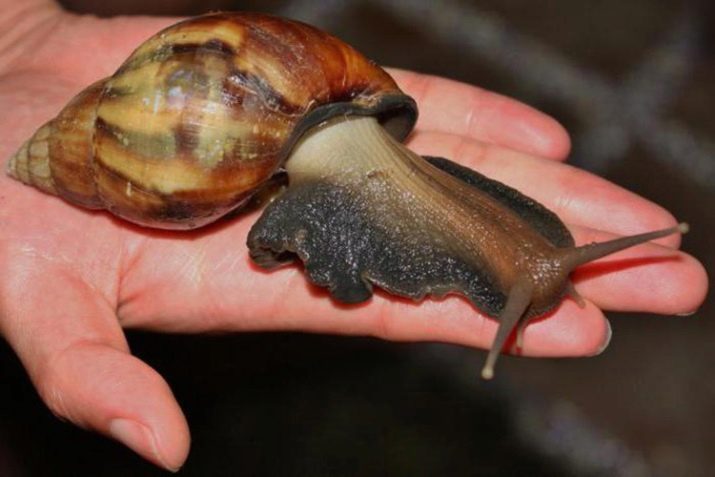
Description
Achatina snails are large mollusks of impressive size. In their natural environment, they live in the tropics, mainly in the countries of eastern and southern Africa - Tanzania, Mozambique, Kenya, Somalia. They are found in Southeast Asia - in Thailand, on the island of Kalimantan. This huge land snail grows a shell 5-10 cm long; individuals up to 20 cm in size are found.
The sizes of the largest snail in the world - it also belonged to the genus Achatina, is even more impressive. Together with the sole Achatina Fulica reached 39.3 cm in length, and its shell grew to 27.3 cm. The weight of the giant individual was 900 grams. But amateur breeders most often see much more miniature individuals.
The shell of Achatina has a peaked shape; in an adult mollusk, it has 8–9 turns. Snails grow throughout life, but after laying eggs this process slows down significantly.The shell may have a different color with characteristic red-brown stripes, yellow, greenish tint.


Spread
Initially, giant Achatina lived in Africa, and there is a theory that they got there from other continents. By the end of the 19th century, snails were transported by humans outside the original habitat. So Achatina appeared in India and on the island of Mauritius. In the XX century, the spread continued - they settled Sri Lanka, Thailand and other regions of Asia. During the Second World War, spectacular giant mollusks entered the United States and quickly multiplied in the climate of Hawaii and California that was comfortable for them.
By the middle of the 20th century, Achatina were discovered in New Guinea and Tahiti. Further, the spread affected the islands of the Caribbean. These mollusks managed to easily adapt to new biotopes due to their high invasiveness.
In many countries of the world they are today recognized as a pest capable of destroying agricultural land.

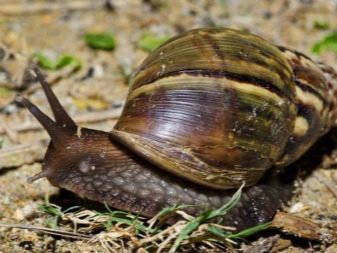
Varieties
The genus of the giant African snail Achatina has many varieties adapted for keeping at home. In total, there are more than 60 of them in nature. And in Russia and Europe, amateurs most often contain the following types of mollusks.
- Achatina Fulika. At home it grows up to 17 cm, the cone-shaped shell is twisted, the body has a light brown or beige color, black varieties are found. The shell has a reddish-brown tone, gradually stripes appear on its surface, the hue is washed out. The snail is omnivorous, easy to maintain, lives up to 8 years.
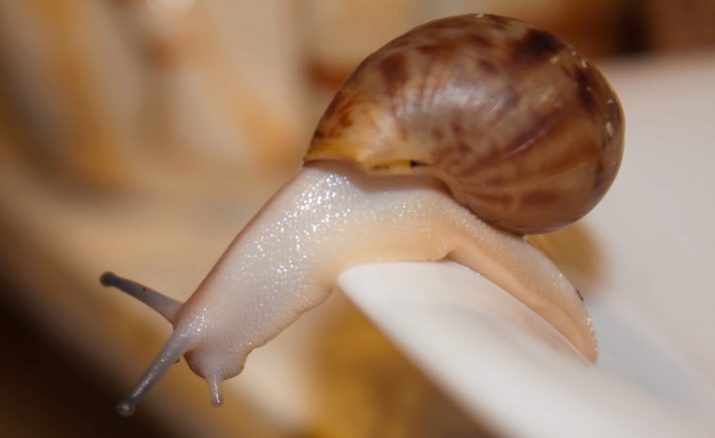
- Achatina reticulate. Zanzibar variety of snail, has an unusual corrugated shell, reaching a length of 18 cm. The color of the shell is white or brown, on the surface there are dots, axial stripes. The snail is quite curious, unpretentious in food, active throughout the day. In captivity, lives up to 6 years. Albino varieties are especially appreciated.
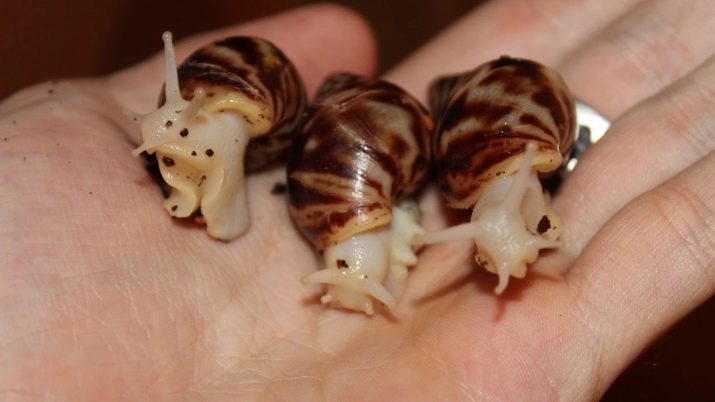
- Achatina Immaculate. Originally from Tanzania, it looks like a fulica, with a beautiful lush shell, a color similar to the peel of a watermelon. It grows to 12 cm, has a beige-brown or sand color, apex in tone.
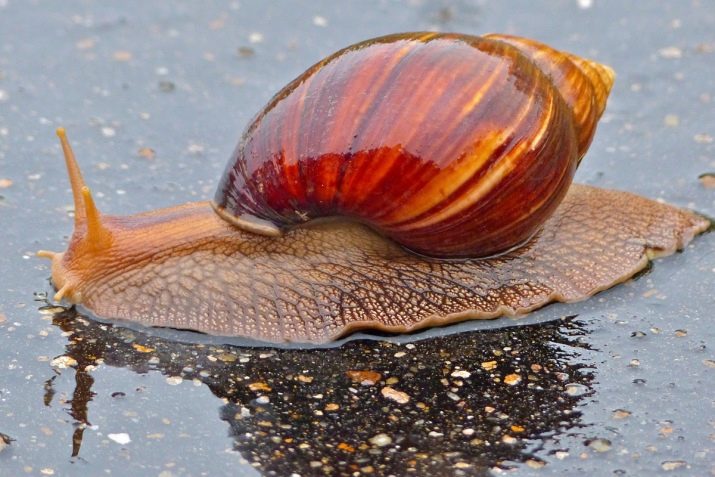
- Lemon Achatina. A rare variety from Zanzibar, with a cream-colored sole and lemon-yellow shell, grows up to 6 cm. It differs from brothers in belonging to viviparous species, reproduces from 7 months, and brings 25 babies twice a year.
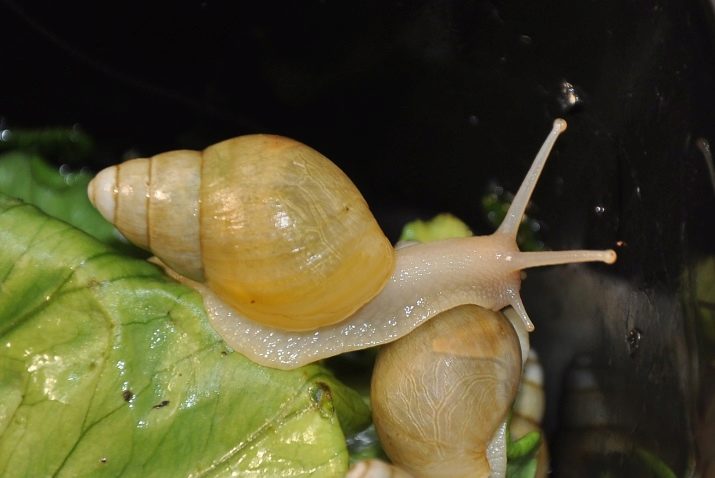
- Tiger or common Achatina. Variety with a characteristic striped shell color. The largest, in nature grows up to 33 cm, in the aquarium - up to 25 cm. The shell is barrel-shaped, color from lemon to saturated red, stripes are black-brown, contrasting. There are individuals with a black, brown, white body.

Is it worth it to start?
These beautiful land snails are able to diversify the leisure of their owners, while being devoid of the disadvantages of other pets. With them you do not need to walk in the rain and snow, suffer from allergies, spend time and energy on the selection of feed. Everything you need - from the container to the bedding, is cheap, replenishment is rare.
Snails are vegetarians who do not need expensive or inaccessible food. In addition, the secret - mucin released from the sole during movement, is characterized by wound healing properties and increases the tissue's ability to regenerate. It is widely used in cosmetology, and home procedures are in no way inferior to salon ones in effectiveness.
In addition, to have an exotic pet at home is fashionable and completely burdensome.
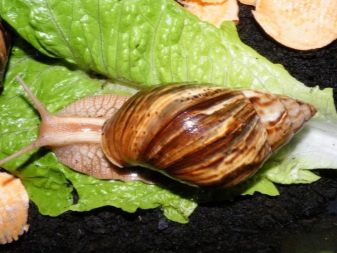
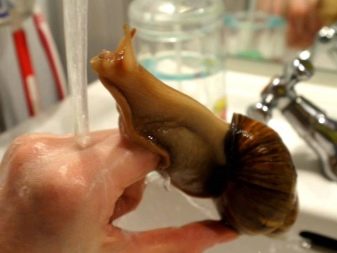
How to determine the age?
At home, snails Achatina are able to live from 5 to 10 years. The record holder is a representative of the type of fulik who has lived 35 years. In nature, these terms can be even longer.But how to determine the age of an acquired individual, to understand whether it is adult or young? In addition to buying very small pets, whose birth date is precisely known, no one will give guarantees in solving this issue.
But there are signs by which you can indirectly understand the approximate age of the pet.
- Addiction to a certain type of food. Young snails prefer fresh herbs and vegetables. Adult Achatina prefer food that is slightly rotten or begins to deteriorate.
- The color of the shell. It is believed that with age it acquires a greenish tint. But such a sign can be associated with the features of the diet.
- The number of turns of the shell. By 8–9 years old, the adult snail has a carapace with 6–9 bulges forming a spiral.
- The ability to form masonry. It appears in individuals no younger than 25 weeks old. It is possible to notice the forming caviar through the spiracle located in the shell.
- The development of the penis. It develops by 25 weeks on the neck, looks like a convex neoplasm.
It is not necessary to consider the dimensions of the shell as the main criterion for determining age. The fact is that after laying eggs, the mollusks completely stop their growth or slow it down greatly.
In addition, compact dimensions will remain for life if the snail lived in cramped conditions.
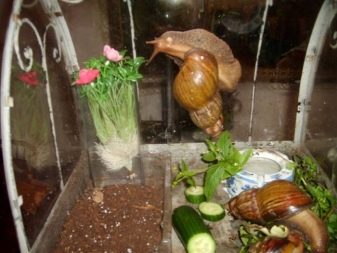
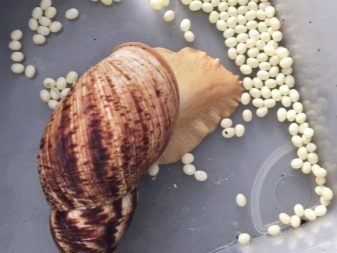
How to know the gender?
Achatina snails, like many other giant mollusks, are hermaphrodites with sex characteristics inherent to both males and females. A larger individual usually takes on the female role, therefore, reproduction will be successful if a smaller and younger brother is planted in the ularia. With solitary confinement, achatins are capable of self-fertilization.
Do not be surprised if one day a snail living without a partner gives its owners offspring.
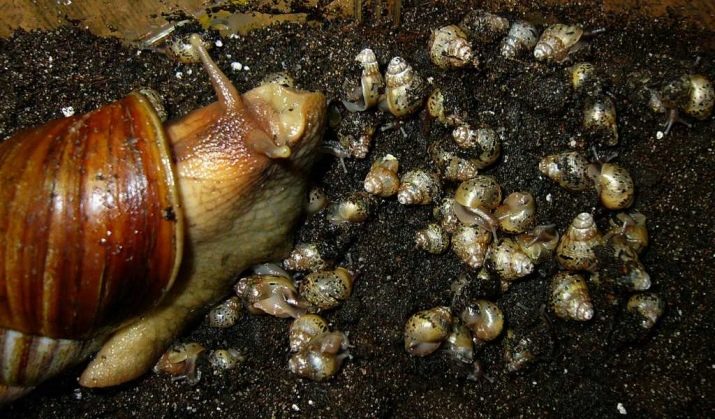
How are they different from archahatines?
Achatina and archahatina snails are African mollusks belonging to two genera of the same family Achatinidae. The main differences of some from others are:
- Apex shape. The rounded tip of the shell is characteristic of archachatins; in Achatina it is more pointed.
- The end of the legs. The archahatines on it have a characteristic groove, and the shape of this process is V-shaped.
- Features of the structure of the soft body. If the clam leg is soft, smooth to the touch, has a characteristic division into large segments, this is Achatina. Archachatina has a finer mesh sole, with rough, hard skin.
- Behavior. Achatina are much more active, agile and inquisitive. Archakhatins are slow, much more timid than their counterparts.
- Breeding. More than 20 eggs are rarely found in clutch of archahatin. They are ready for masonry in 1-1.5 years, while Achatina from 6 months enter puberty.
Given these points, one can successfully distinguish one species of snail from another. But the joint content of representatives of different genera is not recommended due to possible cannibalism.
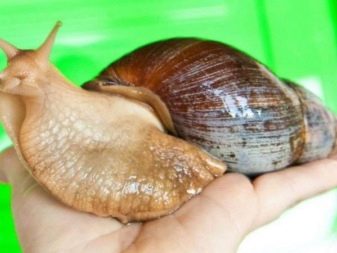
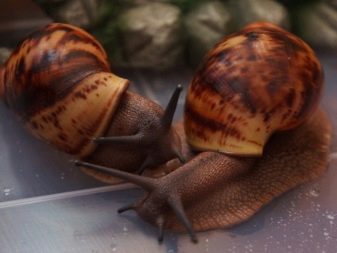
Maintenance and care
Achatina are unpretentious giant mollusks that need to create a comfortable environment for them. For living, they are allocated an aquarium, a terrarium or a container with a wide bottom and a volume of at least 15-20 liters. A lid is necessary, the rows of ventilation holes are made in the case on one side below, on the other in the middle of the tank.
Land snails need a litter in the form of moss, a coconut substrate that retains moisture well. Irrigation and moistening of the soil is carried out daily, but in moderation. Sand, fallen leaves can be mixed into a coconut substrate. Cleaning excrement, food debris is necessary daily. Soil washing is carried out weekly, general cleaning is needed once a quarter. Lighting can be natural, no backlight needed.
It is important to observe the optimum temperature regime - from +24 to +28 degrees. With a decrease in atmospheric temperatures, the mollusks weaken, hibernate. To wake them up, it is enough to increase the temperature and humidity in their habitat.

Feeding
Achatina are omnivorous, but prefer a vegetarian diet. Young individuals prefer fresh herbs, strong fruits of plants. Fresh cucumbers, squash, pumpkin are well eaten, you can give them fresh cabbage, carrots, tomatoes. These mollusks are kind to berries - you can offer them raspberries, watermelon, strawberries, sweet fruits (bananas, apples). In order not to accustom Achatine to a uniform diet, it is worth periodically adding new products to their diet.
Useful for snails is fresh greens - leaves of oak, birch, dandelion. They are thoroughly washed and chopped beforehand. To feed small snails, vegetables and fruits are crushed with a grater. For the formation of the shell, mineral dressing is needed on the basis of chalk, sepia, shell rock, egg shells. For growth, animal and vegetable proteins are needed in moderation - such food is given no more than 3 times a week.
The frequency of feeding an adult snail is every other day. Actively growing young animals are fed 1-2 times a day. In the aquarium, you need a container of water for drinking and swimming.
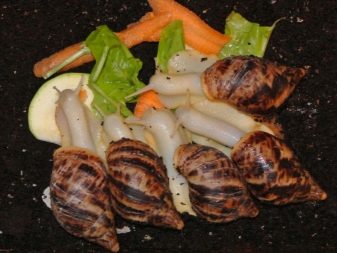
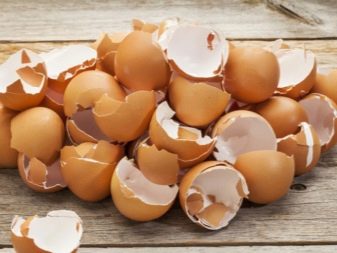
Breeding
Breeding Achatina in captivity is possible both in the presence of several individuals, and in solitary confinement. They are hermaphrodites from birth, small snails are ready for fertilization by the age of 6 months, but at an early age they produce only spermatozoa. When mating two individuals of the same size, both participants in the process can be fertilized. If one Achatina is clearly larger than the other, it will be the massive individual that will bear the eggs, since the process of procreation requires large energy costs.
The readiness of Achatina to mating is indicated by the appearance of a small white tubercle on the right on the neck. Depending on the role of the individual, it can be retracted or transformed into the male genital organ, protruding forward. Close mating is not recommended.
The selected pair is placed in a separate container, left alone. Within two hours, a marriage ritual takes place, accompanied by close bodily contact. After mating, the cochlea, which acts as a female, does not need to be re-fertilized up to 2 years - the male’s semen reserve is enough.
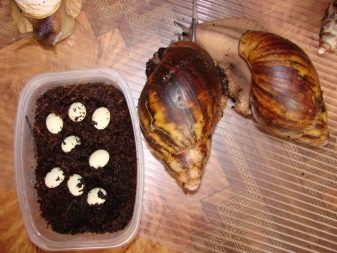
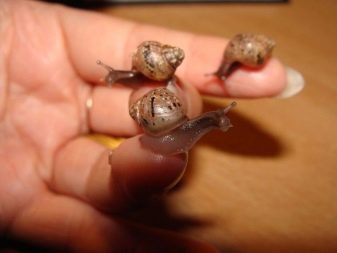
Rules of treatment
When handling Achatina, it is sufficient to comply with the minimum hygiene requirements and be careful. It is unacceptable to take the snail with dirty hands, sweating palms. On the surface of the skin there should be no cosmetics, either caring or decorative. It should be excluded should the pet's contact with salt, chemical detergents.
Correctly picking up a giant clam follows:
- wash your hands thoroughly, leaving them slightly damp;
- immerse your hand in a container or aquarium, palm up in front of the pet's muzzle;
- wait until the snail crawls to the place offered to it;
- raise with your second hand holding the carapace.
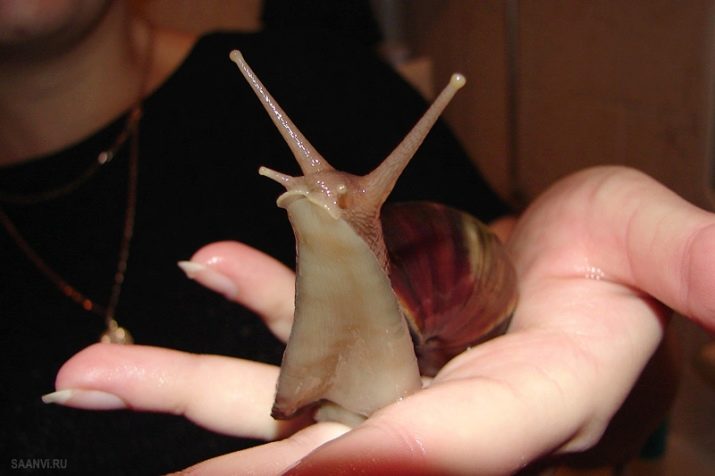
If Achatina is on the wall or lid of the aquarium, do not unfasten it by force. It is enough to moisten the surface of the sole and glass with water, and then slightly pry the body of the pet from the bottom. The snail will easily move into the palm of your hand. It is necessary to exclude the rise of the mollusk by the sink in order to avoid its deformation and damage. You can not scare the clam with loud sounds or sudden movements.
Care should be taken to transfer the pet back to the aquarium or container. Carefully putting the back of the hand on the ground or litter, you need to wait until the sole of the mollusk descends from the palm of your hand. After this, you must close the street sign.
Communication with Achatina should always be scheduled for the evening hours, when the snail exhibits activity inherent to it by nature. At the first contact, she most likely dares only to look out of her shelter under the sink. Further, having mastered, the pet will actively explore the territory, leaving in its way a special lubricant - mucin. You can establish tactile contact by lightly stroking the snail's skin. But the carapace without need not be touched - it is quite fragile.
After games and communication, you should definitely wash your hands thoroughly - despite the proven usefulness of mucin, the sole with which it is carried can have microorganisms on the surface that are unsafe for humans.

Possible difficulties
Most oddities in the behavior of the pet may well have a reasonable explanation. So, in nature during the day, snails can bury themselves in the ground in order to maintain a comfortable level of moisture on the body. When settling in a new place, Achatina will also prefer to stay in a place protected from light and dangers.
Temperature violation
Tropical guests - snails do not tolerate excessive heat. An increase in temperature in their shelter above +28 degrees will force the mollusk to hide where it is wet and cool. This is normal behavior, corrected by moving the tank to a room with a more comfortable climate. When the temperature drops to +23 degrees and below, the opposite effect is possible - from the cold, the snails rise upward as high as possible or burrow into the ground, retaining heat.
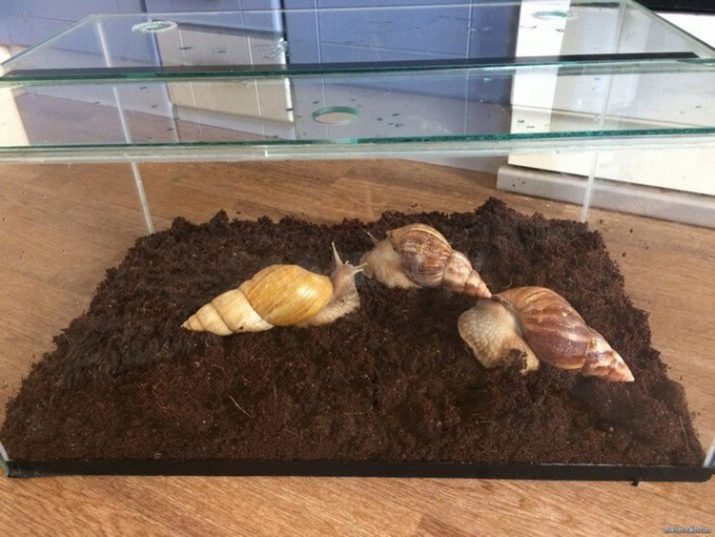
Aquarium drought
At home, with a lack of moisture, the Achatina snail repeats the behavior of its wild counterparts. She simply goes into hibernation or spends most of the day in moist soil. A hygrometer will help control moisture evaporation. In addition, it is necessary to correctly and accurately position the ventilation holes, regularly moisten the litter.
Direct sunlight directed at the aquarium or the proximity of heaters can lead to death of the cochlea. Accelerated drying of the soil can lead to intense dehydration, fatal to mollusks.

Masonry period
Changes in the behavior of Achatina are most often associated with preparation for egg laying. For 1 time they leave in the ground about 200 balls with a diameter of a large pea. From the moment of mating to the masonry stage, about 2 weeks pass, then the bearing in the mantle ends. Eggs buried in the soil remain in the moist soil until new snails hatch from them. The productivity of the species is about 40%, the remaining embryos are empty.
Babies who are just born, prefer to spend time in the wet surface layer of the litter. Here they gain strength, protect their fragile shell from the destructive influence of direct rays of the sun.
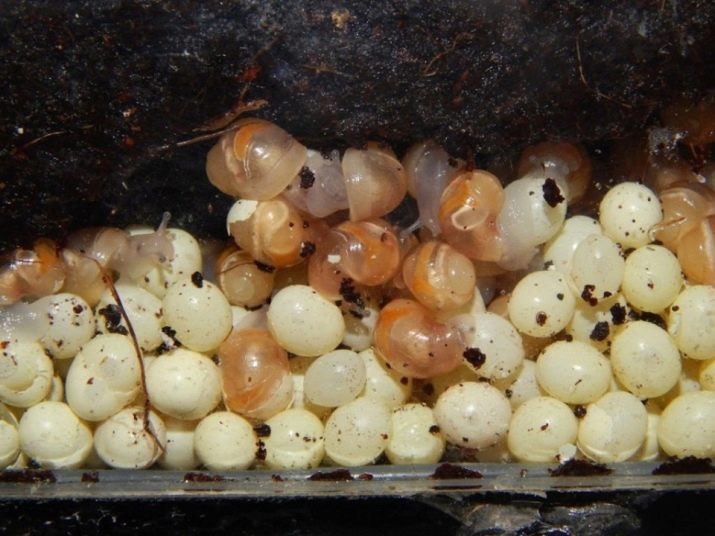
Incorrect menu selection
Refusal of food may be due to the fact that the snail simply does not like specific foods. A win-win option is usually baby puree without salt and sugar, milk, salad leaves, bananas, cucumbers.

Constantly in a dream
Daytime sleep is the norm for giant snails, the time of their activity falls on the night hours. If a pet prefers to indulge after a meal on the walls or ceiling of the container, this is considered the norm. At the same time, they are left with a serving of food at night, healthy pets will easily cope with its destruction. Drowsiness combined with refusal to eat can be a sign of illness.
Any problems in the content of Achatina are most often associated with errors in care or improper selection of the menu. Having better studied the pet's behavior, you can immediately determine whether the snail is naughty or really feels bad.
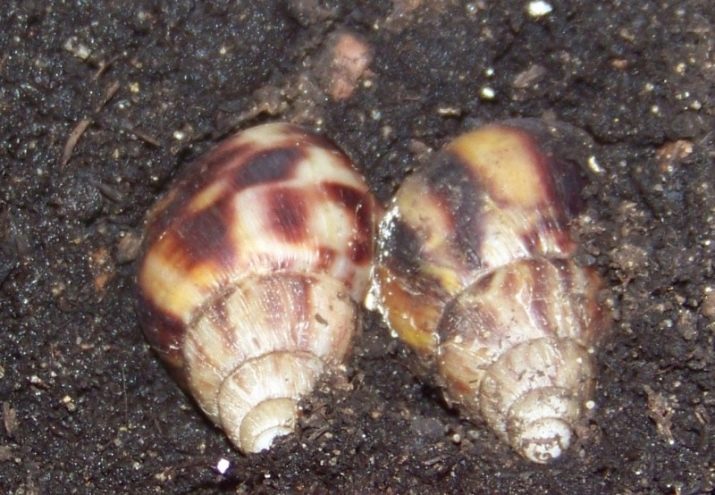
Unusual information
Akhatin is difficult to classify as classic pets. However, it has its advantages, as well as unusual habits and characteristics that the owner should know about. Among the most unusual information about these snails are the following.
- The ability to hibernate. The period of voluntary retreat lasts up to 6 months. The main reason for this is a decrease in ambient temperature to +8 degrees and below. The mouth of the shell during this period is closed by a mucous flap.
- Ability to sing. In any case, breeders call the sounds that Achatina makes. In fact, they resemble something between a whistle and a squeak.
- Fatal danger from salt and sugar.For Achatina, these substances in their pure form are truly poison.
- Suitability for food. In South African countries, snails of the species Achatina are eaten, appreciated for their high protein content and lack of fat.
- Sports talents. In the UK, street races for Achatina are organized and they gather a considerable audience, bringing the owners a chance of material reward. True, do not forget that at the same time such snails are recognized as the slowest on the planet. But in the pursuit of fresh cucumber, they have no equal.
- The ability to move even along razor blades. The mucous substance - mucin produced by the sole - makes it possible to perform such tricks without risking life.
- Myopia. Achatina’s visibility range is only 3 cm, but it clearly distinguishes between light and shadow.
- Special water absorption. Due to the climate, tropical mollusks are used to extracting water from the air, literally soaking it with the body.
- Deafness. Akhatins use touch as the main source of information about the outside world. They have no hearing; the mollusks are completely deaf.
- The nose is out. The tentacles of Achatina are its organ of smell, an analogue of the nose. That's just the mucous membrane is not inside, but outside. The sensitivity is quite high - the snail smells for 2 meters.
- High intelligence. Of course, for a clam. Akhatina recognizes the owner, remembers the location of objects, is able to ponder the situation, make decisions.
- Stamina and strength. On its carapace, a snail can lift a load equal to 10 values of the weight of its own body.
- The presence of 20,000 teeth. In fact, the mollusk does not chew, but scratches food - that is why it is possible to offer it mineral stones for the construction of a shell. Their snail easily drains in a short time.
- Gigantic sizes. At home, a land snail grows a shell up to 20 cm in length. Larger individuals are found in nature. It is known that the largest achatins reached 35 cm in length and weighed more than 2 kg.
- Incredible fertility. Over the course of its life, 1 adult individual can find the happiness of parenthood up to 4,000,000,000 times - it is precisely so many eggs that it leaves on average in clutch.

Of course, these are far from all facts about Achatina. But even a list of 15 items helps to understand how unique these creations are and how many secrets they can still reveal to their owners.
Review Reviews
Owners of Achatina snails are rather willing to share information about their pets. Most reviews look very optimistic and allow you to appreciate all the advantages of such pets. Interestingly, many people become owners of such unusual pets by chance. And only then, finally falling in love with unusual and very easy-to-care creatures, they begin to breed them purposefully.
Not without difficulties. Untrained owners of exotic Achatina in the first weeks of life with a pet face a lot of difficulties. For example, maintaining a certain level of substrate moisture and choosing it often seems too complicated. The new owners do not know about the ban on salt and spices, trying to offer the snail food generously seasoned with various additives.
Especially often mentioned is the delight that Achatina causes among people around. Friends and relatives who come to visit are guaranteed to be busy for several hours only with contemplating a pet. A big surprise for owners may be the birth of offspring - congenital hermaphroditism and the ability to self-fertilize can give unexpected results even with prolonged solitary maintenance of achatina. If you overlook the masonry, there is a risk of becoming the owner of several dozen Achatina right away.

For more information on Achatina, see the next video.
